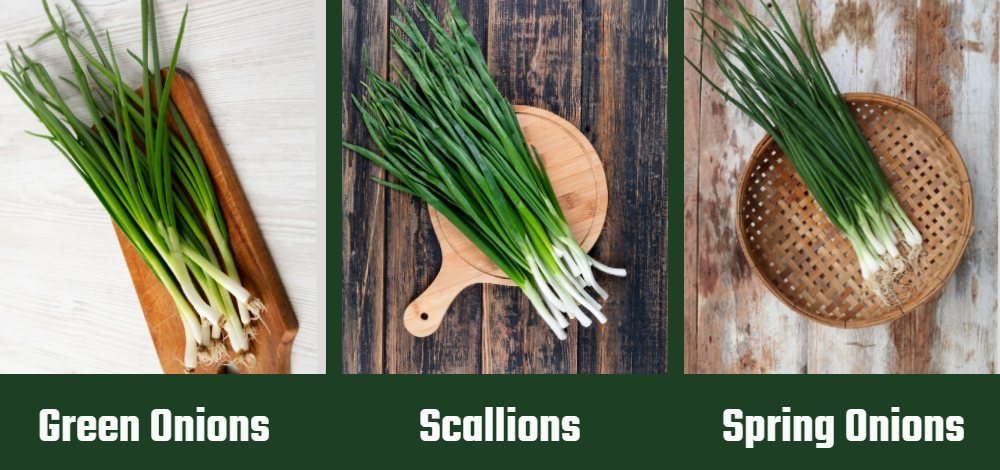Green Onions vs. Scallions vs. Spring Onions: Pros, Cons, & Differences
-
Shea Cummings
- Last updated:

These are three plants that are often easily confused. Their names are also used interchangeably a lot. But the fact is, green onions, scallions, and spring onions have some differences.
The differences between green onions and scallions are minor—we’ll look at why that is. And spring onions vary in some significant ways, such as looks and taste from the other two.
This article will explore each of these plants and give a brief overview of them. We’ll also talk about the best way to use them and how easy they are to grow at home.
Overview of Green Onions & Scallions
The only thing separating a scallion and a green onion is the stage of growth they were in when harvested. When harvested as a younger plant, they are called scallions, and green onions when older.
Sometimes, they will even be labeled interchangeably in the grocery store, but it’s easy to tell them apart yourself. A scallion’s bulb is usually no wider than the stem or leaves because it didn’t have the time to grow.
A green onion bulb isn’t nearly as big as a spring onion’s, but it’s a bit wider than a scallion. Typically, the bulb is more oval than round and is slightly bigger than the stem and leaves.

What Does it Taste Like?
Scallions and green onions have that sharper, spicy bite that you would normally associate with red or yellow onions. In the case of a scallion, this flavor is slightly milder compared to a green onion.
Common and Best Uses
Both of these onions can be used in a pinch if you have a recipe that calls for chopped onion. However, the most common thing that scallions and green onions are used for is garnishing on many dishes. They are best thrown on after or at the end of the cooking time.

- They add a nice crunch to a dish
- Healthy
- Readily available
- Can regrow from cut ends
- Wilt fairly quickly once harvested
- The flavor can be a bit strong for some people
Overview of Spring Onions
Unlike the first two onions, spring onions have a couple of significant differences. One major difference is that these are planted in the late fall so that they can grow over the winter and are ready for harvest in the Spring—hence the name.
One important thing about spring onions is that they should be harvested before summer hits. If left in the heat, they quickly dry out and become tough and quite bitter. At this point in their growth, they will be pretty much unusable.
Because they have a much longer growing period, spring onion bulbs are significantly bigger than the other two. As we mentioned, green onions have a much rounder bulb than scallions, and spring onions have a slightly larger and rounder bulb again.

What Does it Taste Like?
Spring onions are much sweeter than their counterparts. Their flavor is more comparable to a sweet onion. However, this flavor quickly turns bitter if left in the ground too long once the days get long and hot in the summer.
Common and Best Uses
Like the other two, these are often used as a garnish. However, because of their unique flavor and size, many people like to grill them whole alongside a steak. Once grilled, they’re tossed in oil with salt and pepper to taste, and you’ve got a great addition to your rice and steak.

- They make a heartier addition to a meal
- Can do more with them than their counterparts
- Adds texture to many dishes
- It can be used in recipes that call for other young onions
- Don’t taste great when harvested later than Spring
- Less availability later in the season
Growing Your Own
When you purchase these young onions from the store, they often have roots and bulbs, which you normally cut off and discard before cooking. If you’re not interested in growing your own, carry on. However, if you’d like to harvest your own onions, don’t throw out those roots!
You can regrow them right there in your kitchen in two easy ways.

Cup of Water
Simply place the roots in a small cup of water. When you put them in the water, ensure that they stand up with the roots down and the stem sticking above the water. After a couple of days, you should see them start to regrow, and in one to two weeks, you’ll be able to harvest them again.
Small Pot
Plant your onion cut ends in a small pot with balanced potting soil. If you’d like a continuous harvest, this is the best way to do it because you can just cut off the onion as it grows without replanting.
Pro tip: use a little bit of organic fertilizer to boost the onion sprouts.
Conclusion
Ultimately, the only significant difference between these three onions is that they grow for different periods of time. Because of this different growth period, other things about the onion vary, such as size, shape, and flavor.
As a result, each of them has slightly different uses in the kitchen. However, the uses are similar enough that each could be used instead of another in most cases.
Featured Image Credit: (L) Liudmyla Chuhunova, Shutterstock | (C) FRIsky photo, Shutterstock | (R) Phonlawat Laothaithun, Shutterstock
Contents

